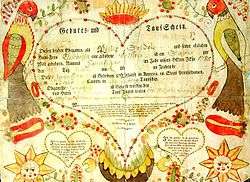Fraktur (folk art)

Fraktur is both a style of lettering and a highly artistic and elaborate illuminated folk art created by the Pennsylvania Dutch (also known as Pennsylvania Deitsch or Pennsylvanian German). Most Fraktur were created between 1740 and 1860.
Fraktur drawings were executed in ink and/or watercolors and are found in a wide variety of forms: the Vorschriften (writing samples), the Taufscheine (birth and baptismal certificates), marriage and house blessings, book plates, and floral and figurative scenes. The earlier Fraktur were executed entirely by hand, while printed text became increasingly common in later examples. Common artistic motifs in Fraktur include birds, hearts, and tulips, as well as blackletter and italic calligraphy.
Today, many major American museums, including the American Folk Art Museum, the Metropolitan Museum of Art, the Philadelphia Museum of Art have Fraktur in their collection. Important Fraktur have been sold by major American auction houses and antique dealers for prices in excess of $100,000. The definitive text on Fraktur is widely considered to be The Fraktur-Writings or Illuminated Manuscripts of the Pennsylvania Germans, written by Dr. Donald A. Shelley and published by the Pennsylvania German Society in 1961. In late 2004, the majority of Dr. Shelley's Fraktur collection was sold at public auction at Pook & Pook, Inc. in Downingtown, Pennsylvania for $913,448.
See also
Further reading
- Hartung, Ruthanne. Fraktur: Tips, Tools, and Techniques for Learning the Craft. Mechanicsburg, Pennsylvania: Stackpole Books, 2008.
- Shelley, Donald. The Fraktur Writings or Illuminated Manuscripts of the Pennsylvania Germans. Allentown, Pennsylvania: Pennsylvania German Folklore Society, 1961.
- Earnest, Corinne and Russell. To The Latest Prosperity: Pennsylvania-German Family Registers in the Fraktur Tradition. University Park, Pennsylvania: The Pennsylvania German Society, 2004.
- Earnest, Corinne and Russell. Papers For Birth Dayes: Guide To the Fraktur Artists and Scriveners. East Berlin, Pennsylvania: Russell D. Earnest Associates, 1997. 2 Volumes.
- Earnest, Corinne and Russell. Fraktur: Folk Art & Family. Atglen, Pennsylvania: Schiffer Publishing Ltd., 1999.
- Earnest, Russell and Corinne. Flying Leaves and One-Sheets: Pennsylvania German Broadsides, Fraktur, and Their Printers. New Castle, Delaware: Oak Knoll Books, 2005.
- Fraktur and Related Works on Paper, The Pioneer Collection of Dr. & Mrs. Donald A. Shelley, Auction Catalogue, October 8, 2004, Pook & Pook, Inc., Downingtown, Pennsylvania - www.pookandpook.com.
External links

| Look up fraktur in Wiktionary, the free dictionary. |
- ExplorePaHistory.com
- Fraktur and related resources.
- Schwenkfelder Museum.
- Pennsylvania Fraktur.
- Penn State University Press To the Latest Posterity, the most recent book published by the Pennsylvania German Society on the Fraktur tradition.
- Pennsylvania German Arts and Antiques: News and Commentary by Clarke Hess
- Auction report by Maine Antique Digest on the auction of the Shelley's fraktur.
- Free Library of Philadelphia - Fraktur - Digital Collections
- Several digitized books on Pennsylvania Dutch arts and crafts, design, and prints from The Metropolitan Museum of Art Libraries